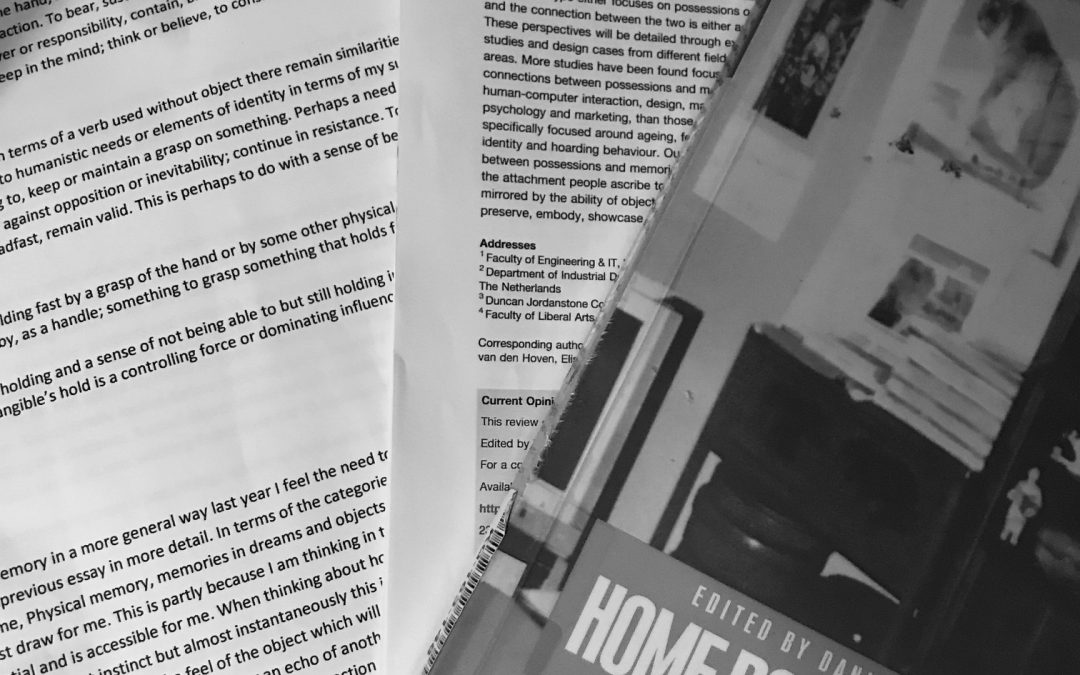My book project ( I’m still calling it that although it may not manifest as an actual book) is a record of my exploration of twelve object of memory which belong to me. The information includes archiving, documents of recollection as well as the process documentation of making, sketching, photographing, clay and painting. It will now also include my essay progression notes and my essay itself once completed. This merging is happening organically and for me needs to happen regardless of the MA requirements. There needs to be a tangible gathering, this book is becoming a richly filled object in itself, for experiencing, remembering and recording my objects. I understand my objects in a new and unique way through the experiences recorded in the book.
I feel that research into memory object is important with much that is physical and tangible for remembering being replaced with digital alternatives. The cloud, selfies and social media holding memories and replacing souvenirs, albums, records, cameras increasingly. My project as a whole has developed through holding, weighing, measuring, smelling, and remembering. Experience an object in both physical and cerebral ways. The outcome of the project for me needs to be physical as well as digital to reflect the importance of this. This is not an anti digital protest as I have no definitive opinion on the progression of the digital, but more a need to experience and acknowledge the value of the physical.
Definition of terms.
Objects
Objects which preserve, embody, showcase, and help us to recollect. How objects are acquired, accessed, used, and owned as well as the way in which we live with them. Archiving, storing and displaying these objects. We have a level of control over the object, choosing where to place it physically, covering and uncovering choosing to have the memory constant or fleeting.
Holding
The physical and phycological sense of holding. What is it to hold? To hold an object, hold onto a memory, keep an object which holds a memory? It is to keep fast, set aside, reserve, to bear, sustain, keep in a specified state, contain, bind or to have or keep in the mind. To remain fast, adhere, cling to, to keep or maintain a grasp on something. Perhaps a need to not let go, to maintain one’s position against opposition or inevitability. To remain attached, faithful, or steadfast, remain valid. There is a sense that to hold something is equally both physical and cerebral.
Memory, which is autobiographical, episodic memory (define) relating to ones own memories, associations with time, place and relationships
Notes.
Making Art – Holding and digesting
The act of making. Environment, interaction, tacit knowledge, artistic know-how, cultural codes mirror the physical interaction with objects of memory. Moving around, interacting with it and others, touching, and experiencing the object with the embodied knowledge we have in place subconsciously and consciously. This relationship between maker and object of making is not unlike the action of experiencing an object from one’s personal experience and allowing the experience to unfold and develop.
Technology – Clouds instead of sleeves
It is difficult to write about object and memory without acknowledging the decline of the physical object such as photographs in favour of digital albums. This has seen the decline of the objects and materials of photography such as analogue cameras and film as well as the physical films, negatives, and printed photograph. The less physical nature of photographs has also allowed for an increase in image in terms of numbers, however there is far less serendipity and error in images which often hold unexpected delights in the act of remembering. Digital photography is uploaded onto social media as an alternative to placing a frame around them and placing onto a tangible surface. Social media itself replaces gifting of photography, being replaced with the act of tagging. Perhaps in the future one’s social media account will be passed on as an heirloom to the living in place of a foxed and frayed black and white photograph.
This could also be applied to music. The Vinyl record and cassette being replaced with digital accounts. The record player lost with the analogue camera. Objects lost to technology. The record, its double sleeve, the carefully considered album design, lyrics, images, artwork. The cassettes unique rattle and cumbersome feeling and the action of rewinding and re- playing.
Object bereavement
When an object of memory is lost or damaged it can leave one with feelings of bereavement and grief. To lose one’s possessions in a fire or natural disaster. To never be able to hold and facilitate memories in the way which only a specific object can facilitate can take time to come to terms with.

Recent Comments